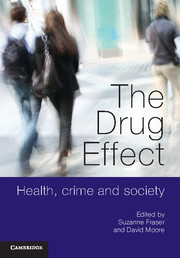Book contents
- Frontmatter
- Contents
- List of contributors
- Acknowledgements
- Introduction
- Part 1 Drug use as social and cultural practice
- 1 The social life of smokes
- 2 Party animals
- 3 Pleasure and pain
- 4 The ontological politics of knowledge production
- Part 2 Drugs, health and the medicalisation of addiction
- Part 3 Drugs, crime and the law
- Index
- References
4 - The ontological politics of knowledge production
Qualitative research in the multidisciplinary drug field
from Part 1 - Drug use as social and cultural practice
- Frontmatter
- Contents
- List of contributors
- Acknowledgements
- Introduction
- Part 1 Drug use as social and cultural practice
- 1 The social life of smokes
- 2 Party animals
- 3 Pleasure and pain
- 4 The ontological politics of knowledge production
- Part 2 Drugs, health and the medicalisation of addiction
- Part 3 Drugs, crime and the law
- Index
- References
Summary
In recent decades, numerous calls for the development of multidisciplinary understandings of drug use and related harm have led to several methodological innovations. These have included the development of mixed-method research approaches such as drug ethno-epidemiology (i.e. combining ethnographic fieldwork and epidemiological surveys) and complex systems approaches such as agent-based modelling (see ‘Agent-based modelling’ below).
In the various commentaries and debates calling for and reflecting on these methodological developments, some have argued that qualitative researchers should suspend their theoretical and epistemological commitments in order to engage in multidisciplinary research. Drawing on my recent involvement in agent-based modelling of amphetamine-type stimulant (ATS) use and related harm in Australia and on recent work in science and technology studies that focuses on the role of all research methods in constituting their objects of study, the chapter considers what might be won and lost when qualitative researchers adopt this ‘suspension’ mode of multidisciplinary engagement. It does not aim to resolve the question of the most appropriate mode of multidisciplinary engagement for qualitative researchers, but to begin sketching an alternative way of thinking about the processes and politics of multidisciplinary drug research, as a stimulus to further discussion and debate.
- Type
- Chapter
- Information
- The Drug EffectHealth, Crime and Society, pp. 73 - 88Publisher: Cambridge University PressPrint publication year: 2011
References
- 6
- Cited by



